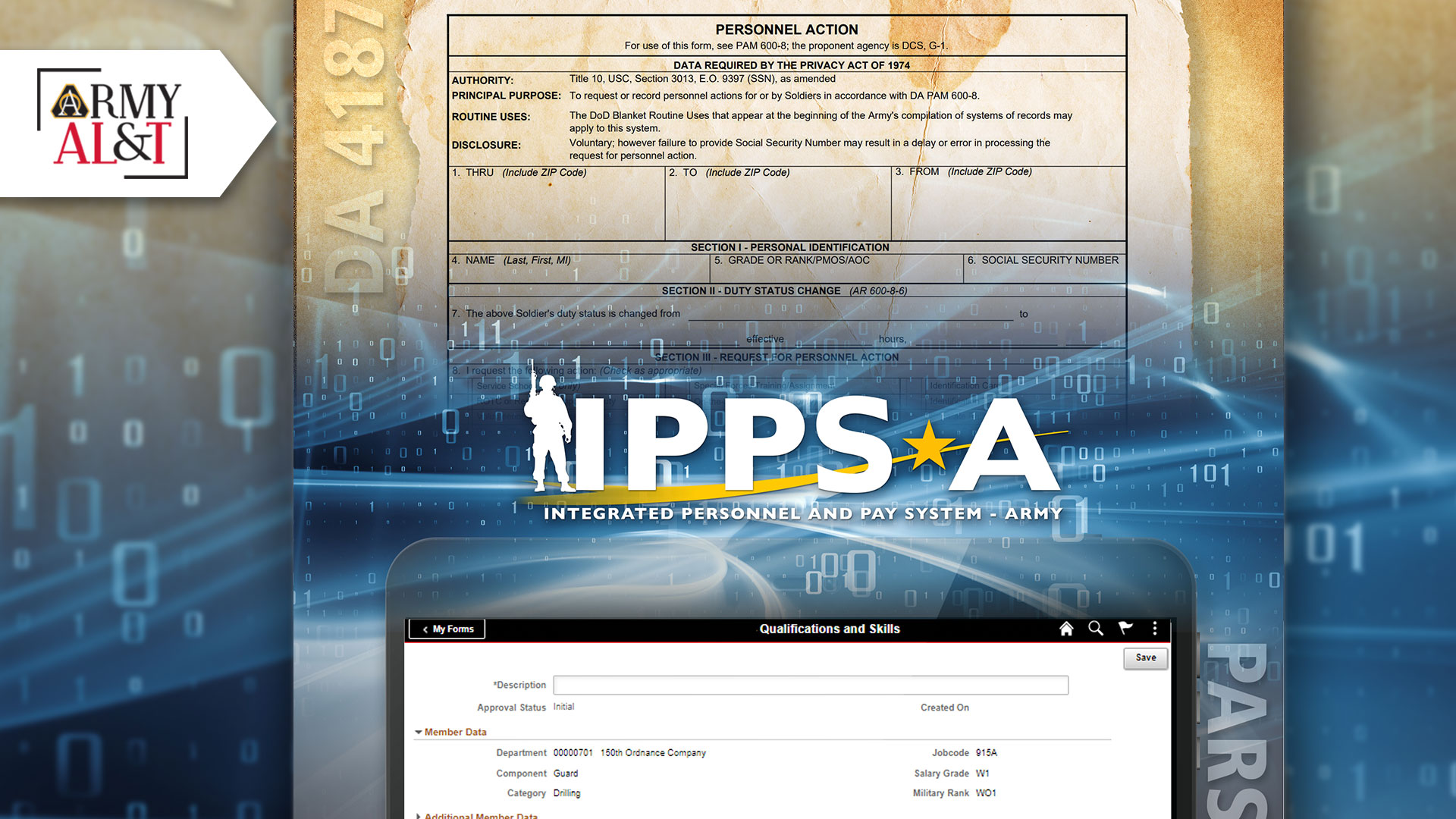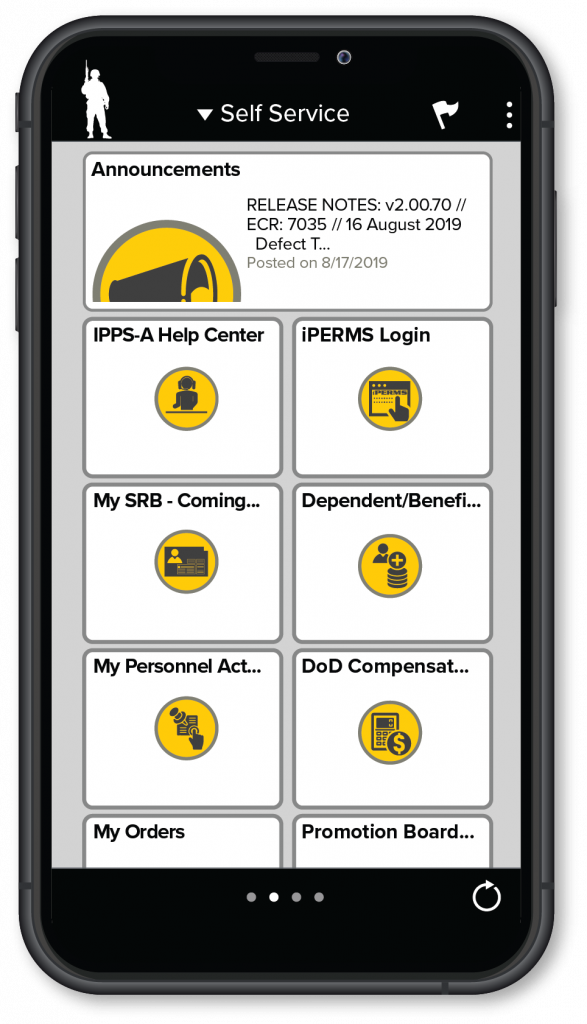
FAREWELL, FORMS: IPPS-A is shredding the Army’s reliance on paper forms for HR actions. The DA Form 4187 and DA Form 31 will soon be submitted electronically via the Personnel Action Request and Absence/Leave requests in IPPS-A. (Graphic by Justin Creech, IPPS-A)
For Army Human Resources, the future is here.
by Col. Rebecca Eggers
The Army strives for a future where Soldiers no longer will waste their valuable time filling out paper forms or trying to figure out the status of their personnel actions. Soldiers no longer will wait in human resources (HR) offices experiencing delays because of legacy system outages or inefficient analog processes. A future where the latest technology ensures personnel actions automatically trigger pay actions, reducing pay errors to ensure timely, accurate pay and minimizing financial hardships for Soldiers.
This December, the entire military force will transition to a 21st century HR system called the Integrated Personnel and Pay System – Army (IPPS-A). IPPS-A will combine personnel, pay and talent management capabilities for all three components—active, Reserve and National Guard—into a single web-based system. This is the Army’s No. 1 HR modernization effort and part of the broader Army People Strategy, which seeks to shift from “distributing personnel” to a system that recognizes the talents and skills possessed by Soldiers and allows the Army to employ each to maximum effect.
Initial operating capabilities are being deployed in incremental releases. This step-by-step approach builds upon capabilities and incorporates user feedback to deliver a better product to Soldiers. In addition, it helps users become familiar with the system before full deployment, as well as enabling the Army to better accommodate required system testing and training. Deployment of releases began in 2015 with Release 1, which built a foundational database of trusted personnel data for future releases.

TRAINING IN SESSION:
The IPPS-A team has conducted extensive training for users, to familiarize them with the new interface and to ensure the rollout is smooth for HR professionals and Soldiers alike. (Photo by Staff Sgt. Jim Heuston, National Guard Professional Education Center)
Release 2 fielding was completed with the Army National Guard in March 2020. The release subsumed two legacy systems and integrated the pay systems of 50 states and four territories to streamline processes and reduce pay errors for Soldiers. For the first time, all 350,000-plus Army National Guard Soldiers are performing electronic self-service personnel action requests, such as changes to marital status, name and beneficiaries. Release 2 also includes 26 military pay actions in areas such as accessions and separations, address changes, incentive pay and seniority dates. Army National Guard Soldiers are paid more accurately and more timely because IPPS-A has a 98 percent accuracy rate in these pay transactions.
Release 3 of the system, which will go live in December, will integrate active-duty and Reserve Soldiers. It will fully subsume an additional 13 legacy systems, serve 1.1 million Soldiers, and be one of the largest HR enterprise resource planning systems in the world. In addition to Release 2 capabilities, Release 3 will add the foundation for leave requests, retirement points, military pay and data services within the system. Release 3 also will include initial talent management capabilities, including the 25-point Soldier talent profile. In that profile, IPPS-A will track both Army system-captured data and information entered into the system by Soldiers, including civilian and military education, awards, attributes, personal goals, civilian work experience and preferences.

TIMELINE TO DEPLOYMENT: IPPS-A has been fielded in two increments and three releases so far. Release 3 is scheduled for December 2021 and will be followed by Release 4 at a later date. (Graphic by IPPS-A)
In the upcoming years, Release 4 will allow IPPS-A to become the authoritative system for military pay. Subsequent releases will increase functionality in each capability area, reduce reliance on outdated legacy systems, and deliver continuous improvement and modernization for users based on Soldier feedback, business process and software updates, and technological advances. At full deployment, IPPS-A will subsume over 30 legacy systems and eliminate over 300 interfaces—providing essential capabilities to the Army, including total force visibility, talent management and auditability. With total force visibility, commanders will use specialized tools within IPPS-A to see, organize and analyze data about every Soldier. Commanders can use these robust tools and reports, which have never been available in one system, to make better-informed decisions when reporting and reviewing command strength to support readiness. Managing talent will be automated to maximize Soldier potential by allowing leaders to differentiate and understand the knowledge, skills and behaviors of Soldiers across the Army. Delivering an audit capability—a secure, comprehensive and searchable tool to support total force readiness, Soldier financial readiness and Soldier career mobility—ensures that the Army’s personnel and pay are compliant with congressional requirements.
INNOVATIVE CAPABILITIES
IPPS-A represents a revolutionary leap forward for Army HR and information technology. Within IPPS-A, transactions are secure, automated, paper-free and trackable from initiation to approval—providing a level of transparency as never before. Digitally automating the approval process for personnel actions reduces manual tracking, response-time delays and loss of documents. IPPS-A’s ability to combine personnel and pay functions (e.g., a promotion or call to active duty) will address current inefficiencies caused by complex interfaces among more than 30 stove-piped HR systems, thereby leaving fewer opportunities for error. For the first time ever, all three components will have a consolidated, authoritative and comprehensive source of Army personnel and pay information within IPPS-A.

IPPS-A ALL DAY: Despite the challenges posed by COVID-related telework, the IPPS-A program has completely rolled out the system to the National Guard, and is continuing to prepare for Release 3, when the active and Reserve components migrate to IPPS-A. (Photo by Justin Creech, IPPS-A)
It will benefit not only HR professionals, but Soldiers and leaders, too. With IPPS-A, Soldiers will have one record for their entire career, even if they switch components. They also will have 24/7 access to their personnel records and self-service capabilities online and through a mobile app—saving time for Soldiers to spend on their mission and with their families. Additionally, providing Soldiers an avenue to express their knowledge, skills and abilities, and preferences delivers two things they want: recognition for their unique talents and more control over their Army careers. Army leaders believe providing Soldiers with more choices in their careers, such as consideration for their preferred jobs and locations, will incentivize Soldiers to perform better and stay longer. Thereby, Soldiers will make the Army stronger.
Leaders can see the 25-point Soldier talent profile for every Soldier in all three components. Ultimately, this 360-degree view of each Soldier will help leaders make better informed talent decisions, ensuring that the right Soldier is paired with the right job. For example, during a pandemic such as COVID-19 that requires personnel with medical skills, certifications and training, commanders could easily input these requirements and search for Soldiers in any component, in any physical location, to support the mission. IPPS-A eventually will initiate a talent marketplace for assignments of enlisted Soldiers and officers that combines one standard model with the talent profile to match assignment preferences between units and Soldiers for all three components. Soldiers will be able to see positions that are available to them, and Soldiers and units can interact and network to increase Soldier, unit and family satisfaction. In turn, IPPS-A will facilitate assessment management and streamline career and succession planning.
For HR professionals, IPPS-A provides automated workflows for pay-impacting HR transactions, such as promotions, to avoid pay delays that may occur in current systems. Streamlined processes not only increase efficiency and productivity, but also reduce errors caused by inaccurate and repetitive data entry. This will ensure Soldiers receive entitled benefits and timely, accurate pay—avoiding financial hardships for Soldiers and their families. IPPS-A is an online solution to fill the capability gap in personnel, pay, talent and data; enhance total Army readiness; and improve the lives of Soldiers and families as part of the Army People Strategy.

THERE’S AN APP FOR THAT: The Army’s new IPPS-A app will allow Soldiers to access and update their own personnel records from anywhere, at any time. (Image courtesy of IPPS-A)
CHANGING THE WAY THE ARMY DOES BUSINESS
The transition to IPPS-A will change how the Army manages personnel actions. Come December, over 150 business processes across three components will be condensed into 46 standardized business processes. This change necessitates updates to laws, regulations and policies. IPPS-A’s most recent operations order providing guidance to commands and units, fragmentary order 5 published in August 2020, detailed the initial 187 laws, regulations and policies requiring modification. These included those that govern military pay and allowances, personnel accounting and strength reporting, military awards, command policy and more, replacing outdated references and adding new policy information.
Over the last year, IPPS-A’s HR transformation team worked with affected Soldiers, HR professionals, commands and units to review key changes and decisions that need to be made to prepare for Release 3. Areas of discussion included audit and internal controls, military pay error resolution, and tools to manage interactions with Soldiers using the system (known as customer relationship management). The team also conducted HR transformation summits during the summer and fall of 2021.
These summits served several purposes. First, they provided a forum for IPPS-A experts to educate the field on the system’s benefits. They also communicated critical knowledge, a lesson learned from Release 2, about how to use IPPS-A and how end-to-end business processes work both inside and outside of IPPS-A. Finally, these summits set conditions for IPPS-A Release 3—how organizations will function in the new environment and how roles, responsibilities and processes will change. This information will ensure HR transactions are performed correctly in the system and will facilitate a smooth transition in December.
To prepare the Army for this major change in HR and pay practices, IPPS-A communicated directly with leaders and experts in all three components; requested and acted upon feedback and lessons learned; developed and distributed educational products; and shared information through discussions, correspondence and social media. These efforts had positive impacts on the system build, requirements and training—enabling the Army to adapt for tomorrow.
CONCLUSION
Modernization efforts will not stop in December. IPPS-A will continue to refine and improve upon the system through 2030. Once Release 3 is fielded in late December 2021, focus will shift to Release 4, which will incorporate additional functionality like base pay, taxes, allowances, bonuses, allotments and leave.
IPPS-A is the Army’s future, and there is still much more to come.
For more information, go to https://ipps-a.army.mil/.
COL. REBECCA EGGERS became the functional management division chief for –IPPS-A in 2021. She is a career Army Adjutant General’s Corps officer, commissioned through the Reserve Officer Training Corps program at Bryant College, where she earned a B.S. in accounting. She also holds an MBA in human resource management from the University of Wisconsin – Whitewater and an M.S. in national resource strategy from the Eisenhower School, National Defense University. Prior to IPPS-A, she served as the division G-1, Combined Joint Forces Land Component Command – Operation Inherent Resolve J-1, Iraq, for the 101st Airborne Division (Air Assault), Fort Campbell, Kentucky, and as the executive officer, joint management officer and 4-/3-star nominations officer in the Army General Officer Management Office, Washington. She also served as the deputy chief, XVIII Airborne Corps, Readiness Division, for the Enlisted Personnel Management Division at Army Human Resources Command, Fort Knox, Kentucky, and she deployed to Kuwait to serve as the chief, Personnel Accounting and Strength Reporting Branches, for the U.S. Army Central.







